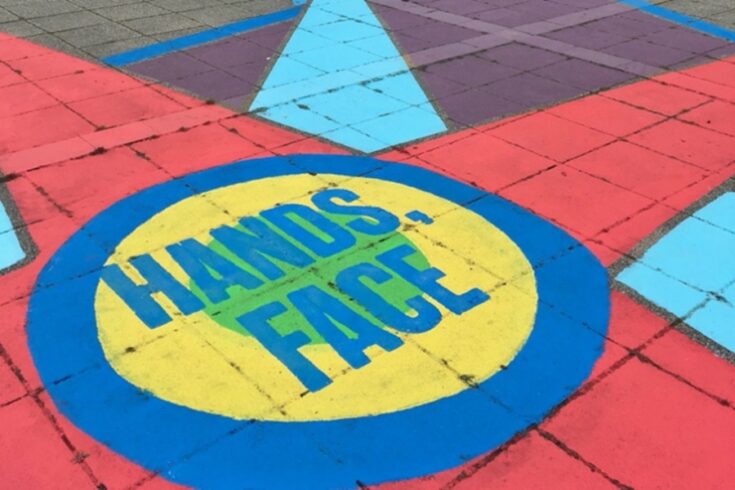The social distancing and reimagining city life project has published its interim report, named ‘performance as city pandemic response: invitations to innovate’.
The report is aimed at city emergency and resilience management staff focused on COVID-19 strategy and response.
The team was funded by the Arts and Humanities Research Council. They will investigate how artistic and everyday performances of cities can inform current and future emergency and resilience planning in the context of pandemic response measures like social distancing.
The project builds on the field research and impact methods developed through work in New Orleans as part of the wider Performing City Resilience project.
Over the last 12 months, the team has:
- interviewed arts leaders and emergency planning and resilience professionals across the UK
- attended and contributed to cross-council pandemic response committees
- conducted extensive field research and analysis of performance practice responding to COVID-19 in the UK and internationally.
The report outlines the similarities in how arts organisations and city emergency planners have had to work during the pandemic. It distils these into a series of invitations for city strategists to think in new ways about their work, and argues for greater collaboration and strategic partnerships with arts organisations.
Emergency challenges
The report identifies five key emergency challenges that arts and resilience strategists are already addressing, and where there is potential for effective collaboration:
- reaching communities in and across a city
- re-working city spaces for safe public access
- engaging local populations with key public health messages
- managing perceptions of life during COVID-19 and of vaccination
- connecting people to alleviate isolation.
Dr Patrick Duggan from Northumbria University, co-lead of the project, explained that the report isn’t about helping city officials use the arts as a tool to solve a problem.
Our job is to reveal the strategic use of arts practice in cities, and identify the ways arts organisations and artists are already involved in the response outside of established council emergency infrastructure.
It’s not about asking artists to be deployed in a particular way, it’s ensuring that emergency and resilience officers are aware of the ways they are already working and how arts practices can add to the ways cities overcome the effects of the pandemic.
Dr Stuart Andrews from Brunel University London, co-lead, said:
COVID-19 has transformed city life: we now need to develop imaginative ideas and creative practices to understand and address its impact on how we live and work in cities. Performance theory and practice offer innovative, proven, yet under-explored means to achieve this. This project is providing new models for city life, helping people cope with social distancing, both practically and emotionally.
Cities across the UK
The research team worked with decision-makers in Bristol, Glasgow and Newcastle to understand how everyday innovations and artistic interventions have helped cities and their inhabitants respond to COVID-19.
Andrews says the report doesn’t list recommendations and suggest transplanting what worked in one city to another. Instead, it offers invitations to think about new models of pandemic response identified by the team.
It’s about valuing effective local practices and inviting arts and emergency planners to think creatively about what might be useful in the places where they work.
Getting artists and arts organisations in the room when decisions are being made would be a valuable first step.
Improving the everyday experience of the pandemic
The report highlights some of the initiatives that artists and arts organisations undertook during various stages of lockdown.
Slung Low theatre company in Leeds curated a public exhibition of pictures made by local residents. The pictures were cable-tied to lampposts for people to explore during their daily hour of exercise.
Swirling shapes were painted on the paths outside the BALTIC Centre for Contemporary Art on the Gateshead side of the River Tyne. In and among the shapes, public health messaging were included: hands, face, save.
In Glasgow, the Citizen’s Theatre’s learning team established a new project to help fill the gap left by the ban on physical gatherings. ‘Through my window’ invited women in the Gorbals area of the city to perform through open doors and windows at set times, connecting them to others while remaining secure.
Andrews said:
Arts practitioners, especially those who work in specific places and with particular communities, have the local knowledge and imagination to help address emerging challenges.
These playful, sustainable interventions connected people, relayed public health messaging in a resonant way and offered entertainment, distraction and joy during a challenging time.
Creative, quick responses
The project’s interim report demonstrates the vital role arts practitioners have played in responding to the challenges created by the pandemic.
One of its key findings was that there is a lack of communication between academics and professionals in the arts, and those working in emergency and resilience management.
Duggan said:
Arts venues and organisations have direct communications with communities that aren’t necessarily available to ‘official’ channels.
It is too easy to value the arts in a city and not allow them to inform the daily practice of managing emergency and resilience preparedness and response.
Whether in enhancing long-term planning, or emergency response, our research reveals the critical, tangible contribution of the arts to emergency and resilience response.
Next steps
The Social Distancing and Reimagining City Life team is leading a series of workshops in 2022 for arts and resilience professionals. They will:
- share findings and invitations to rethink city strategy development/emergency response
- invite participants to identify new, locally-situated ways of addressing the challenges their city faces in the context of COVID-19
- encourage participants to reflect on ways that arts practice could be built into their cities’ preparedness and response to future emergencies.
To receive project updates, get in touch with the research team or express interest in attending a workshop, fill in the form on the Performing City Resilience website.
Last updated: 31 January 2022

